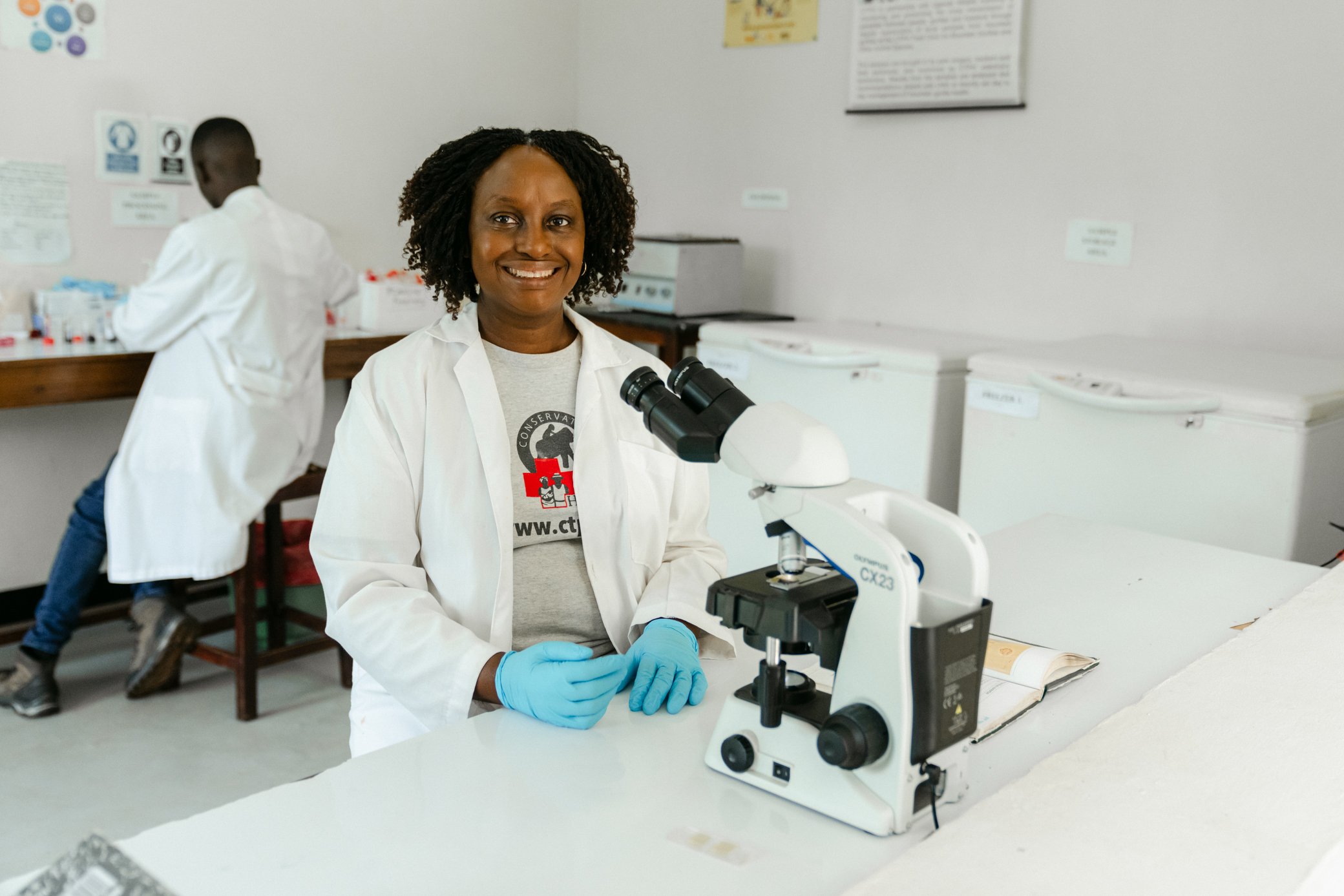Championing Gorilla Conservation and Community Health
Dr. Gladys Kalema-Zikusoka
Serendipitous is how I describe my meeting with Dr. Gladys during my time in Uganda. One afternoon, we were driving back to our accommodation at Volcanoes Bwindi, and Shaun, our local guide and driver from Ellington Safaris, looked over at me and said, "You know, I have someone I think you might be interested in meeting." My interest was piqued when he told me she was a gorilla veterinarian and had started a non-profit supporting the local community and the gorillas. This is just a modest introduction to her work. I sat down to dinner with Dr. Gladys and her husband, Lawrence, that evening at Volcanoes Lodge.
Dr. Gladys Kalema-Zikusoka in her lab
A Small World
It didn't take long for a rapport to form when we discovered our shared North Carolina ties. From 2000 to 2003, Dr. Gladys studied at North Carolina State University to receive her Master's in Specialized Veterinarian Medicine. During her studies, she worked at the nearby Asheboro Zoo, and I visited there for a 10th-grade field trip in 2000. She and her now husband Lawrence were even engaged in Wilmington, where I attended college. How I had never discovered her and her work before now boggles my mind, but again, meeting her in her home country of Uganda years later was fortuitous.
Did you know?! Humans share 98.4% of our DNA with gorillas
The Early Years
Dr. Gladys was born in Kampala, Uganda, in 1970, the youngest of six siblings. As she mentions in her book, Walking with Gorillas, her maternal grandfather, Martin Luther Nsibirwa, was the prime minister of the Kingdom of Buganda from 1929-1941 and again in 1945. Buganda is a sub-nation within Uganda comprising the country's central region, including the capital of Kampala. At this time, Uganda was still a British protectorate, and at 62 years old, her grandfather was tragically assassinated. Even more heartache followed when, on January 20, 1972, her father, William Wilberforce, a Senior Cabinet Minister responsible for Commerce and Industry, left his house and never returned. He was abducted by General Idi Amin's (The Butcher of Uganda) soldiers and murdered at forty-five years old. Her mother became a widow at forty-two and decided to remain in Uganda despite threats and the hardships that followed.
By age twelve and an already established love for animals, Dr. Gladys had decided she would become a vet. She attended the Dollar Academy, a boarding school in Scotland, thriving in an environment where she was the minority and faced occasional discrimination. After two years in Scotland, Dr. Gladys returned to Uganda to attend King's College Budo and Kibuli Secondary School. At Kibuli, she revived the school's Wildlife Club, where, admittedly, her focus was more on growing the club than her studies. Due to this, she had to re-sit for exams in England, scoring high enough to get her admitted into the Royal Veterinary College of England, her first-choice school.
Throughout her time in veterinary school, she worked with several zoos and wildlife parks. Her time at Twycoss Zoo was when she was introduced to working with wildlife, specifically primates. After hearing a talk about the mountain gorillas of Rwanda given by Dr. Barkley Hastings, the first veterinarian to work with mountain gorillas, and Dr. Ian Redmond, the first research assistant of Dr. Dian Fossey, it further fueled her desire to work with mountain gorillas.
Dr. Gladys and Wildlife Health Labratory Technician Laurence Muruhuura analyzing gorilla fecal samples
How Gorillas Helped Reduce Poverty in Uganda
During her last year in veterinary school, Dr. Gladys was invited by the director of Uganda National Parks to research the parasites and bacteria in the gorilla's intestinal tract at Bwindi Impenetrable Forest. During this time, she met Peace Corps volunteers who were involved in a new (for the time) conservation through the International Gorilla Conservation Programme (IGCP). The goal was to help the Ugandan government establish ecotourism by profit-sharing funds from gorilla tourism to the local community. Tourism was changing the lives of the locals, as many former poachers were now working in the park as park rangers, protecting the very animals they used to hunt to feed their families. In her book, Dr. Gladys says, "I began to understand that conservation wasn't simply about the animals, but also about the communities."
A True Trailblazer
Through these studies, the opportunity arose—or rather, Dr. Gladys boldly created —to become the first wildlife veterinarian for Uganda National Parks. She was not just the first female Ugandan wildlife vet, though she was that, too, but simply the first Ugandan wildlife veterinarian, period. From relocating giraffes and elephants to combat their extinction in Uganda, educating the national parks on the importance of human intervention with wildlife when necessary, to the discovery that completely transformed her approach to conservation, her time with Uganda National Parks shaped her into the veterinarian and conservationist she is today.
Dr. Gladys analyzing gorilla fecal samples for diseases
Why Does Conservation Through Public Health Matter?
The discovery that changed Dr. Gladys's future was the diagnosis of scabies in the gorilla group Katendegyere in 1996. This gorilla group would leave the forest and roam in the community gardens nearby, an impoverished area without resources or education on proper hygiene. Because the animals had come into contact with their clothing on the lines, they had contracted scabies and were quickly deteriorating. They were treated promptly with ivermectin and antibiotics, though sadly, the infant, Ruhara, did not survive. Gorillas share 98.4% of human DNA, making them highly susceptible to contracting human diseases. It was from this encounter that in 2003, Conservation Through Public Health (CTPH) was born.
CTPH has three areas of focus: Gorilla Conservation, One Health, and Alternative Livelihoods.
Hands from a gorilla in the Habinyanja family, Bwindi Impenetrable Forest
CTPH's mission is "To promote biodiversity conservation by enabling people, gorillas and other wildlife to coexist through improving their health and livelihoods in and around Africa's protected areas." Their vision is "A world where gorillas live in a secure environment co-existing with healthy communities." How is this accomplished? The short answer is to educate the local villages about health and hygiene practices, including family planning. CTPH currently has 430 volunteers who visit the local villages surrounding Bwindi National Park to educate and track their progress.
Other volunteers, including the "Gorilla Guardians," are called to relocate the gorillas back into the forest when they wander out to eat from the farmer's banana trees. As it had become clear that humans directly impacted the health of the gorillas living around them in the forest, it also became clear that to engage the local communities in conservation efforts, those communities should also be receiving compensation for the money gorilla tourism was bringing in if they wanted their help. Many locals became park rangers, porters and coffee farmers, earning more in one day than they could previously make in a month.
According to Walking with Gorillas, gorilla tourism accounts for 8% of Uganda's GDP, 60% of which comes from Bwindi. $10 of every gorilla trekking permit is given back to the local communities, and 20% of park entry fees from all of the national parks throughout Uganda are shared with the local communities by the Uganda Wildlife Authority. Despite these strides, when COVID struck, it highlighted a glaring over-dependence on tourism for survival. When tourism, the primary source of income for many local communities, was suspended, the local people were left without a way to support their families, and some reverted to poaching to feed their families.
The third area of focus for CTPH, alternative livelihoods, would now play an even more prominent role. CTPH provided seeds to locals to cultivate gardens, animals for breeding, and, eventually, Gorilla Conservation Coffee. Locals from the communities surrounding Bwindi Impenetrable Forest were supplied with coffee bean seedlings to grow and sell. In return, they were paid a fair market price for their beans when the beans were ready (it typically takes around two years for the plants to mature). Through this program, they now have 630 coffee bean farmers, of which 230 are women. Uganda is the largest coffee-exporting country in Africa.
Above: The Conservation Through Public Health Facilities Overlooking Bwindi Impenetrable Forest
The Far Reaching Impact
Through her work with gorillas and conservation over the past thirty years, Dr. Gladys has received over 35 awards and became a National Geographic Explorer in 2018. In her book, she credits trailblazers Dr. Jane Goodall, Dr. Dian Fossey, Dr. Birutė Gladikas, and Dr. Liz Macfie for paving the road for women in wildlife conservation within the field of primates. She also credits for mother for emphasizing the importance of education and providing the opportunity for her to pursue her dreams. Additionally, during this time, mountain gorillas are now the only gorilla subspecies to be taken off of the International Union for Conservation of Nature (IUCN) critically endangered list as their numbers have surpassed 1000, up from 600 in the '90s.
How Can You Get Involved?
Lawrence Zikusoka , Dr. Gladys Kalema-Zikusoka and Erin Henderson
If gorilla trekking in Uganda is not possible in the future, there are so many other ways you can support Dr. Gladys and the CTPH team from home. You can order their superb coffee, make a monetary charitable donation online, or even purchase Dr. Gladys's book Walking with Gorillas.
If you plan to visit Uganda, you can inquire about trekking with Dr. Gladys or even stay at the CTPH accommodation overlooking Bwindi Impenetrable Forest; the views are fantastic. You can also stop by the Gorilla Conservation Café in Entebbe or volunteer within the local community. If you are lucky enough to go gorilla trekking, be mindful of keeping the 10-meter distance rule from the gorillas and wear your mask during your time with them; these are pretty basic rules that, unfortunately, are often broken by tourists.
I am grateful for my time with Dr. Gladys and her husband, Lawrence. I look forward to following their conservation work and, of course, doing my part by drinking as much Gorilla Conservation Coffee as I can. Will you join me?
You can find more information about CTPH at:











